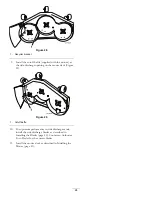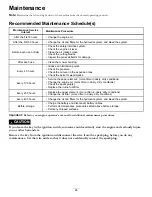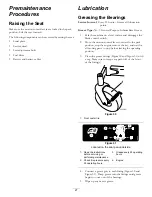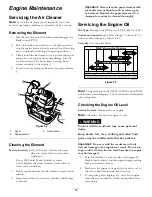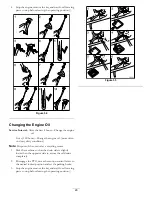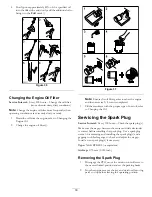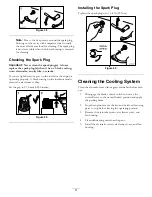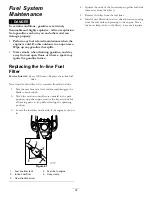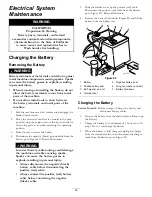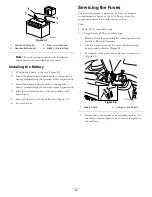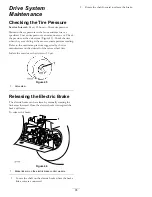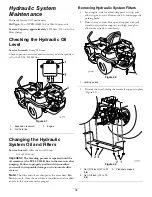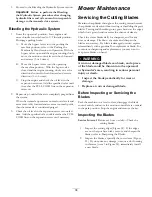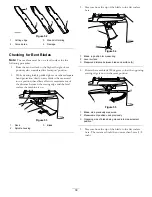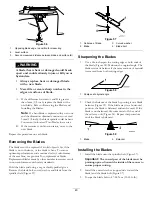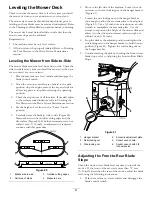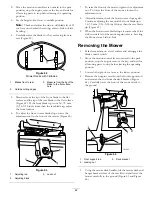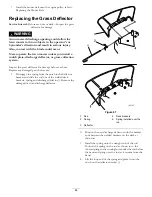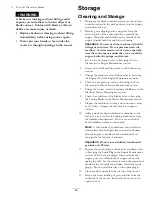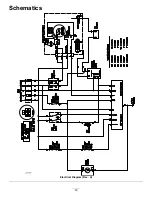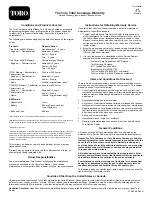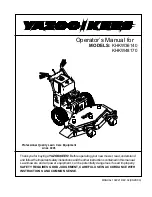
9.
Proceed to the Bleeding the Hydraulic System section.
Important:
Failure to perform the
Bleeding
the Hydraulic System
procedure after changing
hydraulic filters and oil can result in irreparable
damage to the transaxle drive system.
Bleeding the Hydraulic System
1.
Enter the operator's position. Start engine and
move throttle control ahead to 1/2 throttle position.
Disengage parking brake.
A.
Move the bypass levers into the pushing the
machine position; refer to the Pushing the
Machine by Hand section in Operation. With the
bypass valves open and the engine running, slowly
move the motion control levers in both forward
and reverse (5 or 6 times).
B.
Move the bypass levers into the operating
the machine position. With the bypass valve
closed and the engine running, slowly move the
directional control in both forward and reverse
directions (5 to 6 times).
C.
Stop the engine and check the oil level in the
expansion reservoir. Add the specified oil as until
it reaches the FULL COLD line on the expansion
reservoir.
2.
Repeat step 1 until all the air is completely purged from
the system.
When the transaxle operates at normal noise levels and
moves smoothly forward and reverse at normal speeds,
then the transaxle is considered purged.
3.
Check the oil level in the expansion reservoir one last
time. Add the specified oil as until it reaches the FULL
COLD line on the expansion reservoir if necessary.
Mower Maintenance
Servicing the Cutting Blades
Maintain sharp blades throughout the cutting season because
sharp blades cut cleanly without tearing or shredding the grass
blades. Tearing and shredding turns grass brown at the edges,
which slows growth and increases the chance of disease.
Check the cutter blades daily for sharpness, and for any
wear or damage. File down any nicks and sharpen the
blades as necessary. If a blade is damaged or worn, replace
it immediately with a genuine Toro replacement blade. For
convenient sharpening and replacement, you may want to
keep extra blades on hand.
WARNING
A worn or damaged blade can break, and a piece
of the blade could be thrown into the operator's
or bystander's area, resulting in serious personal
injury or death.
•
Inspect the blade periodically for wear or
damage.
•
Replace a worn or damaged blade.
Before Inspecting or Servicing the
Blades
Park the machine on a level surface, disengage the blade
control switch, and move the motion control levers outward
to the park position. Stop the engine and remove the key.
Inspecting the Blades
Service Interval:
Before each use or daily—Check the
cutting blades.
1.
Inspect the cutting edges (Figure 52). If the edges
are not sharp or have nicks, remove and sharpen the
blades; refer to Sharpening the Blades.
2.
Inspect the blades, especially the curved area (Figure
52). If you notice any damage, wear, or a slot forming
in this area (item 3 in Figure 52), immediately install
a new blade.
38
Summary of Contents for 74395
Page 10: ...119 8874 1 Low speed 2 High speed 10 ...
Page 50: ...Schematics g017655 Electrical Diagram Rev A 50 ...
Page 51: ...Notes 51 ...

